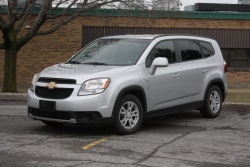 2012 Chevrolet Orlando LT. Click image to enlarge |
Review and photos by Chris Chase
Back to main review,
by Grant Yoxon
Photo Gallery:
2012 Chevrolet Orlando
The Chevrolet Orlando might be about as worldly as a car can get: this compact seven-seat MPV (multi-purpose vehicle) is a European model that’s manufactured in South Korea and named after a major U.S. tourist destination.
The irony of it all, though, is that despite bearing the badge of an American carmaker and the name of a place in that country, it isn’t sold there. Such are the differences between the Canadian and U.S. auto markets — and the similarities shared by Canada and other parts of the world — that we get the Orlando and Americans can’t have it.
Small, tall wagons like this are a big deal in Europe. They were a big deal here, too a number of years ago, before minivans, SUVs, and crossovers got big (figuratively). Then minivans, SUVs, and crossovers got big (literally) and created a niche market (again) for smaller vehicles like this Orlando and its key competitors, the Mazda5, Kia Rondo, and the forthcoming Ford C-Max.
 2012 Chevrolet Orlando LT. Click image to enlarge |
This is not the type of vehicle that sets hearts afire. However, we Canadians do like our practical vehicles, hence the Orlando’s availability here but not across the border.
All three Orlando trims (LS, LT and LTZ) use the same 2.4-litre, four-cylinder engine that makes 174 horsepower and 171 lb-ft of torque. LS and LT models come standard with a six-speed manual transmission that can be optioned to a six-speed automatic; the top-trim LTZ gets the automatic by default.
My tester was the same LT model with the automatic that Grant Yoxon drove. I’ve tested this powertrain before in the Buick Regal, and it’s just as boring in the Orlando as it was in that Buick, but it’s a better fit here, as the Orlando isn’t the car being marketed as a sport sedan. Still, it’d be nice if the engine and transmission behaved like moving a car around was something they wanted to do.
 2012 Chevrolet Orlando LT. Click image to enlarge |
The transmission is a lazy piece of work that’s reluctant to downshift at speed, and always feels like it’s second-guessing itself while shifting up through its six ratios during normal acceleration. Each shift is accompanied by a gentle lurch and just doesn’t feel very refined. That is, until you put your foot into it. Then the six-speed will happily bang off crisp, smooth, quick upshifts all day long. I haven’t driven an Orlando with the stickshift, but perhaps the few buyers who choose it will find it to be a better partner for this engine.
Grant says he found the Orlando provided “more than sufficient” acceleration, but I’d take out the “more than” qualifier and suggest the motor is strong enough, but only just. It has to work hard to get the Orlando up to speed; you can be in all the hurry you want, but the car won’t comply. Just as in the Regal, the 2.4L never sounds happy about being pushed hard. Granted, an MPV isn’t the type of vehicle that attracts hotshoe drivers, as evidenced by the even more leisurely Mazda5. (That car’s engine at least sounds happy enough to be worked hard.)
 2012 Chevrolet Orlando LT. Click image to enlarge |
Not that the Orlando necessarily needs more power, but the turbocharged 2.0L motor used in the Regal would be a good fit here. Even tuned down from the 220 horsepower and 258 lb-ft of torque it makes in that Buick, the turbo’s extra low-end grunt would be a good complement to the Orlando’s capacity for bulky cargo.
Power delivery complaints aside, the Orlando delivered impressive real-world fuel efficiency, averaging 11 L/100 km, in mostly city driving, punctuated by a few trips around Ottawa’s suburban arteries, against Natural Resources Canada’s estimates of 10.1 L/100 km city and 6.7 L/100 km highway. That Regal averaged 10.4 L/100 km with the benefit of warmer weather and more highway driving; I call the Orlando’s result a win considering its less aerodynamic shape (the Orlando and Regal weigh about the same).
    2012 Chevrolet Orlando LT. Click image to enlarge |
I second Grant’s positive comments on the Orlando’s suspension: as a contrast to the unsatisfying drivetrain, the Orlando’s underpinnings are everything they should be. Its dampers have enough starch in them to control body movement over big waves in the asphalt, but the compliant springs make the ride comfortable. In a week of driving on some of the poorest roads in my part of Ottawa, this suspension did everything right. And for its tall body, the Orlando handles commendably, with (relatively) little body roll and a chassis that seems perfectly content tackling twisty roads with some enthusiasm. Nicely weighted steering is offset by a spongy feeling brake pedal.
A tall roof means headroom is never an issue; even the tight third row has enough to keep adult heads away from the ceiling. The front seats are comfortable, but the top of the backrest hit my shoulders awkwardly. Second row legroom is about equal to what’s found in most compact sedans; the third row, as expected, is small, but useful for smaller adults. Aside from the tendency to squish knees up against the seatbacks in front, the biggest problem is the low bottom cushion, so shorter is better (both in the rider’s stature and the duration of the trip) for those who wind up back here.
Cargo space measures out to a maximum of 1,594 L with second and third row seats folded, or 739 L behind the second row. With all three rows in place, the number shrinks to a tiny 101 L.
Interior lighting could use a boost: the dome light is way back over the rear seats, and the map lights up front don’t light up when a door is opened, leaving the front seats dark when getting in and out of the car at night. In fact, the cargo hold is better lit than the front seating area.
The neatest interior feature might be the flip-up radio panel, which reveals a storage cubby and the why-didn’t-I-think-of-that location of auxiliary and USB inputs. It’s an ingenious touch. No need to pocket or hide a music player every time you get out of the car; just leave it tucked away, out of sight, in what is a very intuitive location.
For a family car with the ability to move seven people in a pinch, the Orlando is as well executed as they come. The well-sorted suspension is an unexpected plus; I only wish GM could have put something as impressive under the hood.











